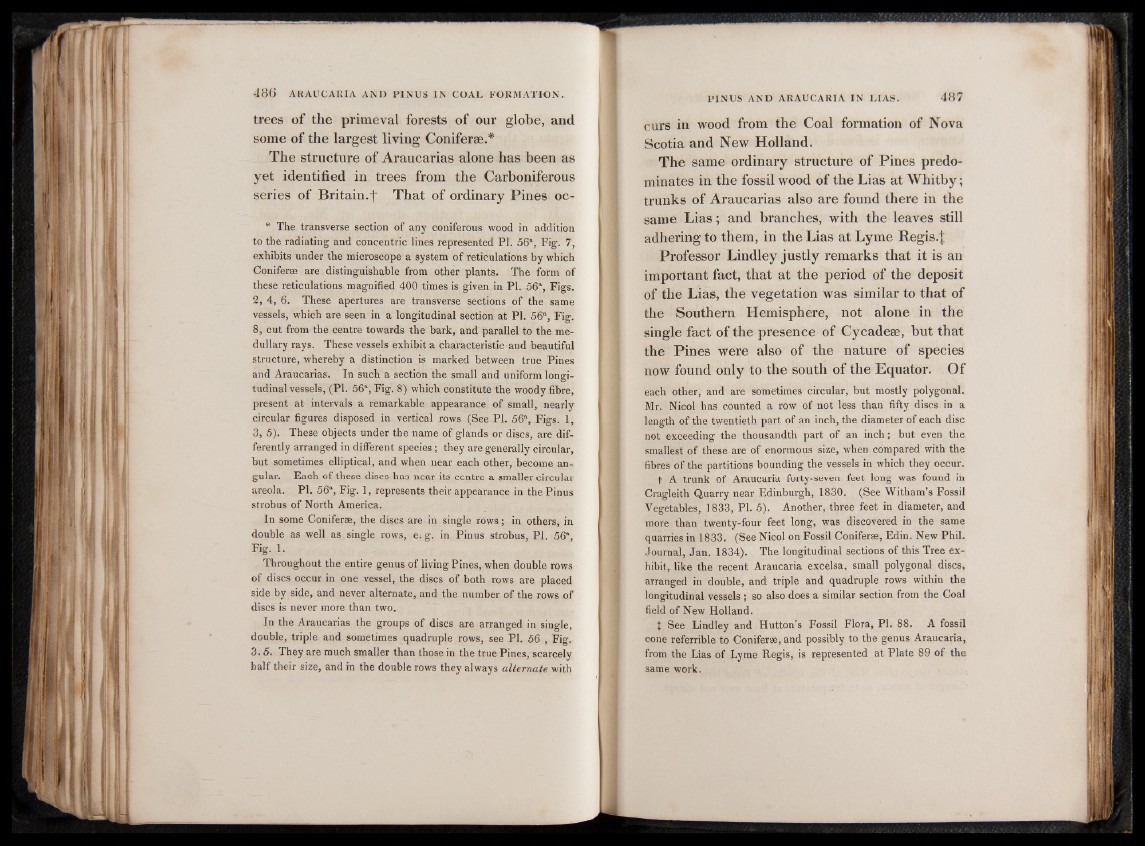
trees of the primeval forests of our globe, and
some of the largest living Coniferse.*
The structure of Araucarias alone has been as
yet identified in trees from the Carboniferous
series of Britain.']' That of ordinary Pines oc-
* The transverse section of any coniferous wood in addition
to the radiating and concentric lines represented PI. 56% Fig. 7,
exhibits under the microscope a system of reticulations by which
Coniferse are distinguishable from other plants. The form of
these reticulations magnified 400 times is given in PI. 56% Figs.
2, 4, 6. These apertures are transverse sections of the same
vessels, which are seen in a longitudinal section at PI. 56% Fig.
8, cut from the centre towards the bark, and parallel to the medullary
rays. These vessels exhibit a characteristic and beautiful
structure, whereby a distinction is marked between true Pines
and Araucarias. In such a section the small and uniform longitudinal
vessels, (PI. 56°, Fig. 8) which constitute the woody fibre,
present at intervals a remarkable appearance of small, nearly
circular figures disposed in vertical rows (See PI. 56“, Figs. 1,
3, 5). These objects under the name of glands or discs, are differently
arranged in different species; they are generally circular,
but sometimes elliptical, and when near each other, become angular.
Each of these discs has near its centre a smaller circular
areola. PI. 56% Fig. 1, represents their appearance in thePinus
strobus of North America.
In some Coniferse, the discs are in single rows; in others, in
double as well as single rows, e. g. in Pinus strobus, PI. 56“,
Fig. 1.
Throughout the entire genus of living Pines, when double rows
of discs occur in one vessel, the discs of both rows are placed
side by side, and never alternate, and the number of the rows o f
discs is never more than two.
In the Araucarias the groups of discs are arranged in single,
double, triple and sometimes quadruple rows, see PI. 56 , Fig.
3. 5. They are much smaller than those in the true Pines, scarcely
half their size, and in the double rows they always alternate with
curs in wood from the Coal formation of Nova
Scotia and New Holland.
The same ordinary structure of Pines predominates
in the fossil wood of the Lias at Whitby;
trunks of Araucarias also are found there in the
same Lias; and branches, with the leaves still
adhering to them, in the Lias at Lyme Regis.];
Professor Lindley justly remarks that it is an
important fact, that at the period of the deposit
of the Lias, the vegetation was similar to that of
the Southern Hemisphere, not alone in the
single fact of the presence of Cycadese, but that
the Pines were also of the nature of species
now found only to the south of the Equator. Of
each other, and are sometimes circular, but mostly polygonal.
Mr. Nicol has counted a row of not less than fifty discs in a
length of the twentieth part of an inch, the diameter of each disc
not exceeding the thousandth part of an inch; but even the
smallest of these are of enormous size, when compared with the
fibres of the partitions bounding the vessels in which they occur.
f A trunk of Araucaria forty-seven feet long was found in
Cragleith Quarry near Edinburgh, 1830. (See Witham’s Fossil
Vegetables, 1833, PI. 5). Another, three feet in diameter, and
more than twenty-four feet long, was discovered in the same
quarries in 1833. (See Nicol on Fossil Coniferse, Edin. New Phil.
Journal, Jan. 1834). The longitudinal sections of this Tree exhibit,
like the recent Araucaria excelsa, small polygonal discs,
arranged in double, and triple and quadruple rows within the
longitudinal vessels ; so also does a similar section from the Coal
field of New Holland.
I See Lindley and Hutton’s Fossil Flora, PI. 88. A fossil
cone referrible to Coniferse, and possibly to the genus Araucaria,
from the Lias of Lyme Regis, is represented at Plate 89 of the
same work.